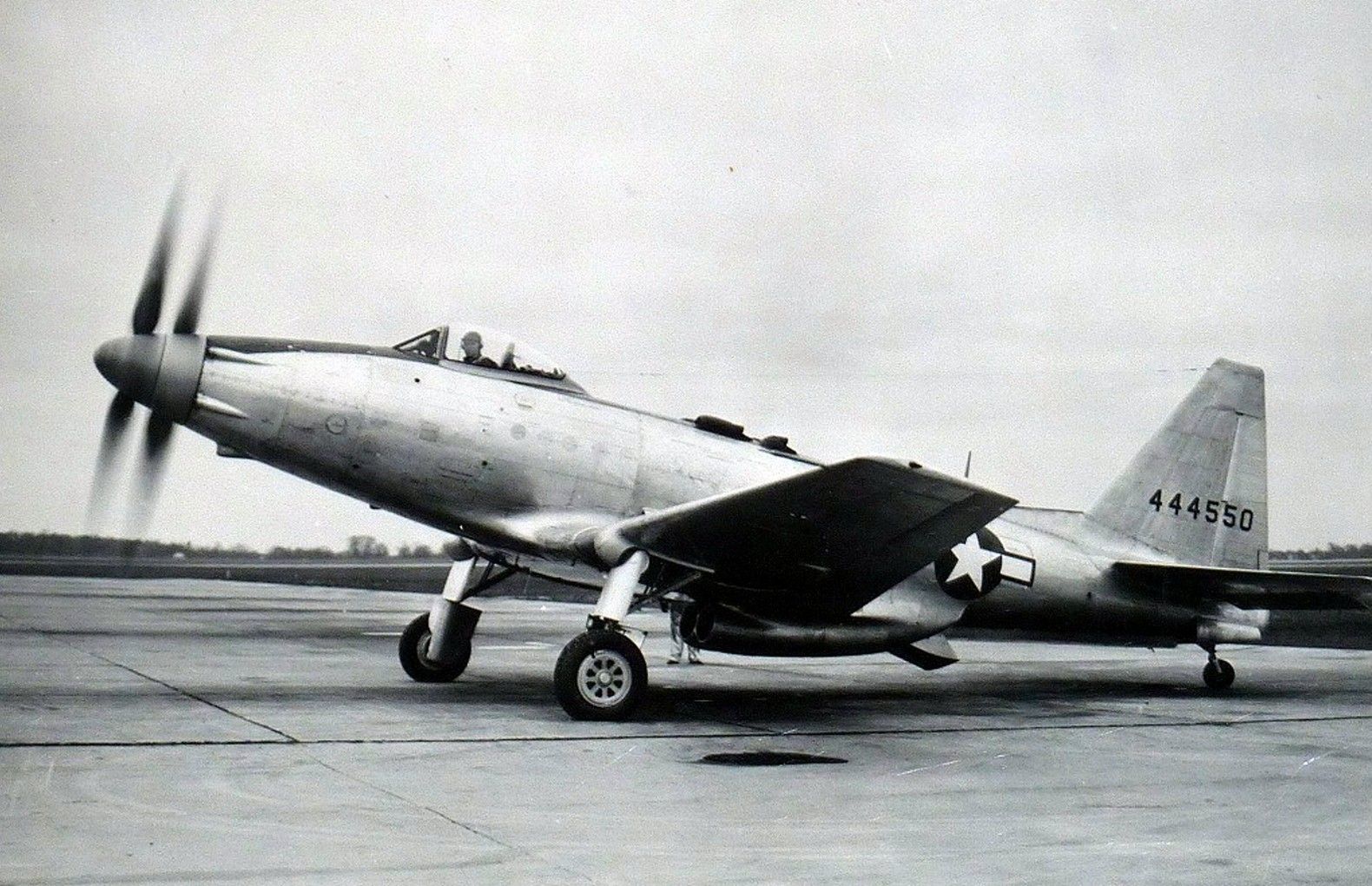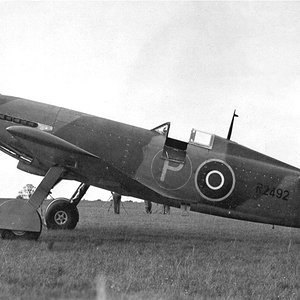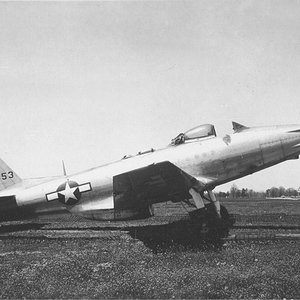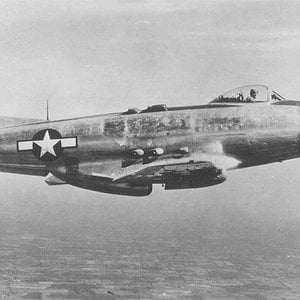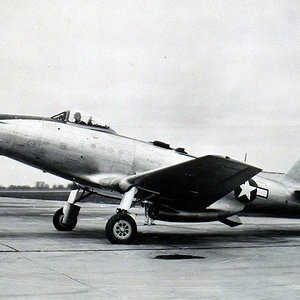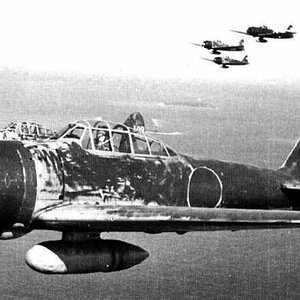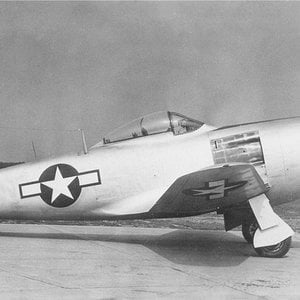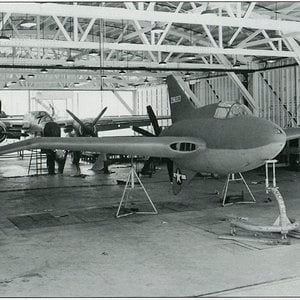Navigation
Install the app
How to install the app on iOS
Follow along with the video below to see how to install our site as a web app on your home screen.
Note: This feature may not be available in some browsers.
More options
You are using an out of date browser. It may not display this or other websites correctly.
You should upgrade or use an alternative browser.
You should upgrade or use an alternative browser.
Design and development
The first XP-75-GM in flight (S/N 43-46950)
In October 1942, the contract for two prototypes, designated XP-75, was signed with the Fisher Body Division of GM. The design concept was to use the outer wing panels from the North American P-51 Mustang, the tail assembly from the Douglas A-24 (SBD), and the undercarriage from the Vought F4U Corsair in a general layout much as in the Bell P-39 Airacobra with the engine located amidships with the propeller driven through an extension shaft. At an early design stage, however, Curtiss P-40 Warhawk outer wing panels were substituted for the P-51 panels.
In mid-1943, the need for long-range escort fighters became more urgent than fast climbing interceptors so a decision was made to order six more XP-75 airplanes modified for the long-range role. At this time an order for 2,500 production aircraft was also let, but with the stipulation that if the first P-75A was not satisfactory the complete order might be canceled.
At the time, General Motors was busy in several projects towards the war effort, including the mass production of several different aircraft types, including the Grumman TBF Avenger. Some sources[2] claim that the P-75 was the result of a scheme to get General Motors out of being forced to build Boeing B-29 Superfortresses; the P-75 project being a "high-priority" project to help GM avoid the added strain of Superfortress production. Bearing the name, "P-75 Eagle" was significant as the designation harkened back to the French 75 gun in World War I, considered a symbol of defeating the Germans. The "Eagle" was given extensive media coverage prior to its first flight, being trumpeted as a "wonder plane".[3]
[edit]Operational history
Fisher P-75 Eagle on display at the National Museum of the USAF in the Research & Development Gallery
Powered by a V-3420-19 24-cylinder engine rated at 2,600 hp driving co-axial contra-rotating propellers, the XP-75 flew for the first time on 17 November 1943. The second XP-75 flew shortly thereafter, with all six long-range XP-75s entering the test program by the spring 1944. The test program brought up a number of deficiencies, including miscalculation of the fighter’s center of mass, failure of the engine to produce its expected power, inadequate engine cooling, high aileron forces at high speed, and poor spin characteristics. Redesigns were introduced into the long-range XP-75s including a modified tail assembly, new "bubble" canopy, and a V-3420-23 engine that corrected most of the problems by the time the first P-75A Eagles entered flight test in September 1944.
By this time, the Army Air Force decided to limit the number of combat aircraft types in production and not enter into large-scale production of new types that might not be available before the war ended. As the twin-engine Lockheed P-38 Lightning, the single-engine Republic P-47 Thunderbolt and P-51 Mustang demonstrated excellent long-range capabilities, the production run of the P-75A Eagle was substantially terminated on 6 October 1944. It was decided to use the six completed production aircraft for experimental work and development of the V-3420 engine. As a result of those events, the P-75A did not complete formal performance trials due to termination of the production contract. Ultimately, only eight XP-75s and six P-75As were built.
[edit]Aircraft on display
Fisher P-75A in flight, side view
XP-75A Eagle, s/n 44-44553, is on display at the National Museum of the United States Air Force in Dayton, Ohio.[4] For many years this aircraft was on display in the museum's Experimental Aircraft Gallery. Extensive deterioration of the airframe was discovered by the staff in 1999, which forced the Museum to undertake a full restoration of the aircraft. The aircraft has been completed and returned to display in the museum's Experimental Aircraft Gallery.
[edit]Specifications (XP-75)
Fisher XP-75 3/4 front view (S/N 43-46950)
Data from [5] and [6]
General characteristics
Crew: One
Length: 40 ft 5 in (12.32 m)
Wingspan: 49 ft 4 in (15.04 m)
Height: 15 ft 6 in (4.72 m)
Wing area: 347 ft² (32.24 m²)
Empty weight: 11,495 lb (5,214 kg)
Loaded weight: 19,420 lb[7] (8808 kg)
Max. takeoff weight: 18,210 lb (8,260 kg)
Powerplant: 1 × Allison V-3420-23 liquid-cooled 24-cylinder double-Vee, 2,885 hp (2,150 kW)
Performance
Maximum speed: 433 mph (697 km/h) at 20,000 (6,100 m)
Range: 2,050 mi (3,300 km)
Service ceiling: 36,400 ft (11,100 m)
Rate of climb: 4,200 ft/min (21.3 m/s)
Wing loading: 39.8 lb/ft² (194.3 kg/m²)
Power/mass: 0.21 hp/lb (0.34 kW/kg)
Armament
6x .50 caliber (12.7 mm) wing mounted machine guns
4x .50 caliber (12.7 mm) fuselage mounted machine guns
2x 500 lb (227 kg) bombs
The first XP-75-GM in flight (S/N 43-46950)
In October 1942, the contract for two prototypes, designated XP-75, was signed with the Fisher Body Division of GM. The design concept was to use the outer wing panels from the North American P-51 Mustang, the tail assembly from the Douglas A-24 (SBD), and the undercarriage from the Vought F4U Corsair in a general layout much as in the Bell P-39 Airacobra with the engine located amidships with the propeller driven through an extension shaft. At an early design stage, however, Curtiss P-40 Warhawk outer wing panels were substituted for the P-51 panels.
In mid-1943, the need for long-range escort fighters became more urgent than fast climbing interceptors so a decision was made to order six more XP-75 airplanes modified for the long-range role. At this time an order for 2,500 production aircraft was also let, but with the stipulation that if the first P-75A was not satisfactory the complete order might be canceled.
At the time, General Motors was busy in several projects towards the war effort, including the mass production of several different aircraft types, including the Grumman TBF Avenger. Some sources[2] claim that the P-75 was the result of a scheme to get General Motors out of being forced to build Boeing B-29 Superfortresses; the P-75 project being a "high-priority" project to help GM avoid the added strain of Superfortress production. Bearing the name, "P-75 Eagle" was significant as the designation harkened back to the French 75 gun in World War I, considered a symbol of defeating the Germans. The "Eagle" was given extensive media coverage prior to its first flight, being trumpeted as a "wonder plane".[3]
[edit]Operational history
Fisher P-75 Eagle on display at the National Museum of the USAF in the Research & Development Gallery
Powered by a V-3420-19 24-cylinder engine rated at 2,600 hp driving co-axial contra-rotating propellers, the XP-75 flew for the first time on 17 November 1943. The second XP-75 flew shortly thereafter, with all six long-range XP-75s entering the test program by the spring 1944. The test program brought up a number of deficiencies, including miscalculation of the fighter’s center of mass, failure of the engine to produce its expected power, inadequate engine cooling, high aileron forces at high speed, and poor spin characteristics. Redesigns were introduced into the long-range XP-75s including a modified tail assembly, new "bubble" canopy, and a V-3420-23 engine that corrected most of the problems by the time the first P-75A Eagles entered flight test in September 1944.
By this time, the Army Air Force decided to limit the number of combat aircraft types in production and not enter into large-scale production of new types that might not be available before the war ended. As the twin-engine Lockheed P-38 Lightning, the single-engine Republic P-47 Thunderbolt and P-51 Mustang demonstrated excellent long-range capabilities, the production run of the P-75A Eagle was substantially terminated on 6 October 1944. It was decided to use the six completed production aircraft for experimental work and development of the V-3420 engine. As a result of those events, the P-75A did not complete formal performance trials due to termination of the production contract. Ultimately, only eight XP-75s and six P-75As were built.
[edit]Aircraft on display
Fisher P-75A in flight, side view
XP-75A Eagle, s/n 44-44553, is on display at the National Museum of the United States Air Force in Dayton, Ohio.[4] For many years this aircraft was on display in the museum's Experimental Aircraft Gallery. Extensive deterioration of the airframe was discovered by the staff in 1999, which forced the Museum to undertake a full restoration of the aircraft. The aircraft has been completed and returned to display in the museum's Experimental Aircraft Gallery.
[edit]Specifications (XP-75)
Fisher XP-75 3/4 front view (S/N 43-46950)
Data from [5] and [6]
General characteristics
Crew: One
Length: 40 ft 5 in (12.32 m)
Wingspan: 49 ft 4 in (15.04 m)
Height: 15 ft 6 in (4.72 m)
Wing area: 347 ft² (32.24 m²)
Empty weight: 11,495 lb (5,214 kg)
Loaded weight: 19,420 lb[7] (8808 kg)
Max. takeoff weight: 18,210 lb (8,260 kg)
Powerplant: 1 × Allison V-3420-23 liquid-cooled 24-cylinder double-Vee, 2,885 hp (2,150 kW)
Performance
Maximum speed: 433 mph (697 km/h) at 20,000 (6,100 m)
Range: 2,050 mi (3,300 km)
Service ceiling: 36,400 ft (11,100 m)
Rate of climb: 4,200 ft/min (21.3 m/s)
Wing loading: 39.8 lb/ft² (194.3 kg/m²)
Power/mass: 0.21 hp/lb (0.34 kW/kg)
Armament
6x .50 caliber (12.7 mm) wing mounted machine guns
4x .50 caliber (12.7 mm) fuselage mounted machine guns
2x 500 lb (227 kg) bombs

